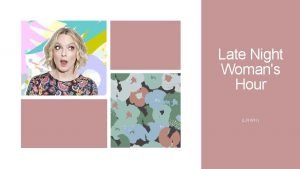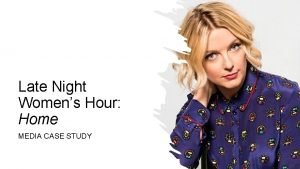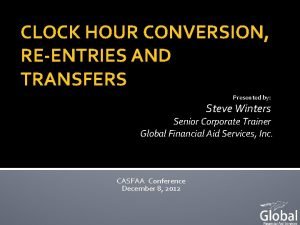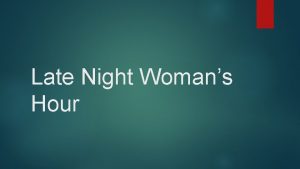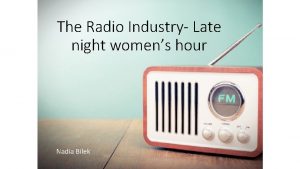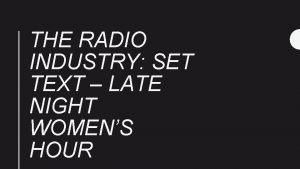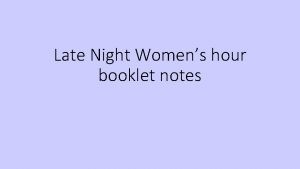Late Night Womans Hour RADIO INDUSTRY CONTEXT SET







- Slides: 7

Late Night Woman’s Hour RADIO INDUSTRY, CONTEXT, SET PRODUCT

Radio Broadcasters Radio public service broadcaster – A radio broadcaster that is seen to offer public service by catering for a range of tastes and audiences. For example the BBC radio. 5 categories of commercial radio stations in the UK: 7 codes and conventions of speech-based radio programmes: • • National commercial radio (Classic FM, Absolute Radio) National brands – regional stations collected into networks (Global Radio containing Heart, Galaxy, Gold and Radio X) Independent local radio – regional commercial stations (Splash FM based in Worthing) Community Radio – serve local areas and produce content of interest to local people, nonprofit. (Worthing FM) Hospital Radio – based in hospitals and staffed by volunteers (Seaside Hospital Radio) • • • Presenter – acts as an anchor to guide the discussion Discussions – groups of people discussing a range of topics Phone-ins – effective, cheap ways of involving the listeners Contributors – Invite guests who tend to be experts/knowledgeable in the topic Drama – Regular shows like the soap ‘The Archers’ Documentaries – May be related to news or current events or music themed Outside Broadcasts – Reporters, presenters & mobile studios bring stories and features from different locations.

The BBC Radio How does the BBC promote its stations and programmes? Scheduling and how it works in BBC radio programming: • Cross-platform marketing; other stations and BBC television will promote events related to BBC radio Stripping – A certain programme is broadcast at the same time everyday. • Billboard and magazine advertisements for stations and presenters • Each station has its own website • Uses promotional films focusing on particular parts of its output • BBC Taster is an interactive service that enables the BBC to show experimental ideas • Radio 1 & 2 have breakfast shows; they are largely music led but do incorporate chat, sport, traffic and slots for specific programmes • Radio 4 uses stripping as part of its schedule: Woman’s Hour and the spin off Late Night Woman’s Hour both have specific times. Woman’s Hour is everyday at 10 am while Later Night Woman’s Hour is once a month at 11 pm

Regulation The regulator for Radio and Television broadcasting industry is OFCOM Ofcom is involved in advising and setting more technical aspects of regulation, implementing and enforcing the law. The role of OFCOM in relation to broadcasting is: • Ensure a wide range of radio services of quality and wide appeal is available • To maintain plurality in the provision of broadcasting • To adequately protect audiences against offensive or harmful material • To protect audiences against unfairness or infringement of privacy

Social and cultural context of LNWH The voice of Late Night Woman’s Hour is Lauren Laverne • The introduction of Late Night Woman’s Hour into Radio 4 demonstrated the BBC’s awareness of the need to cater for all areas of society • Topics discussed within the programme reflect what is interesting and concerning to young women in modern society • Caters for a specified social group who have been previously under-represented

Audience factors that create appeal for radio audiences: • The blind medium – Has no visual images, allows the audience to use their imaginations • The companion medium – Provides strong sense of personal communication for audience; offers interactive opportunities (text or email in to get a ‘shout out’) • The intimate medium – Very personal, encourages intimacy via direct mode of address • The Undemanding medium – Audience can do things while listening Stuart Halls Reception Theory: Preferred reading – Most likely a female audience who can relate to and agree with the content being presented. Negotiated reading – Could be both male or female who relates to some topics being mentioned, they may listen to select episodes rather than all of them Oppositional reading – Mostly likely a male audience who don’t agree or can’t relate to the content being presented; leading to them not listening. Late Night Woman’s Hour Audience Appeal: • • • Lauren Laverne is a similar age to the target audience: her northern accent also subverts the stereotype of typical Radio 4 presenter making her more relatable to the audience Language & Mode of address aimed to a younger female demographic Appeals to a niche, specialised audience Themes appeal to the target audience Widely available across a range of platforms, can be accessed by a global audience.

Curran and Seaton’s Power and Media Industries The BBC: Late Night Woman’s Hour: • BBC is important as a major deliverer of radio and television programmes • Challenges idea of media being run for economic profit, as BBC is a non-profit organisation • BBC as a public service broadcaster and freedom from commercial pressures giving it more scope to produce innovative and creative programmes • The BBC’s need to address a range of audiences • The BBC’s flexibility to create programmes that appeal to minority audiences • BBC radio stations each have distinct style and ethos • Supports the idea that more variation in media companies leads to a greater choice
